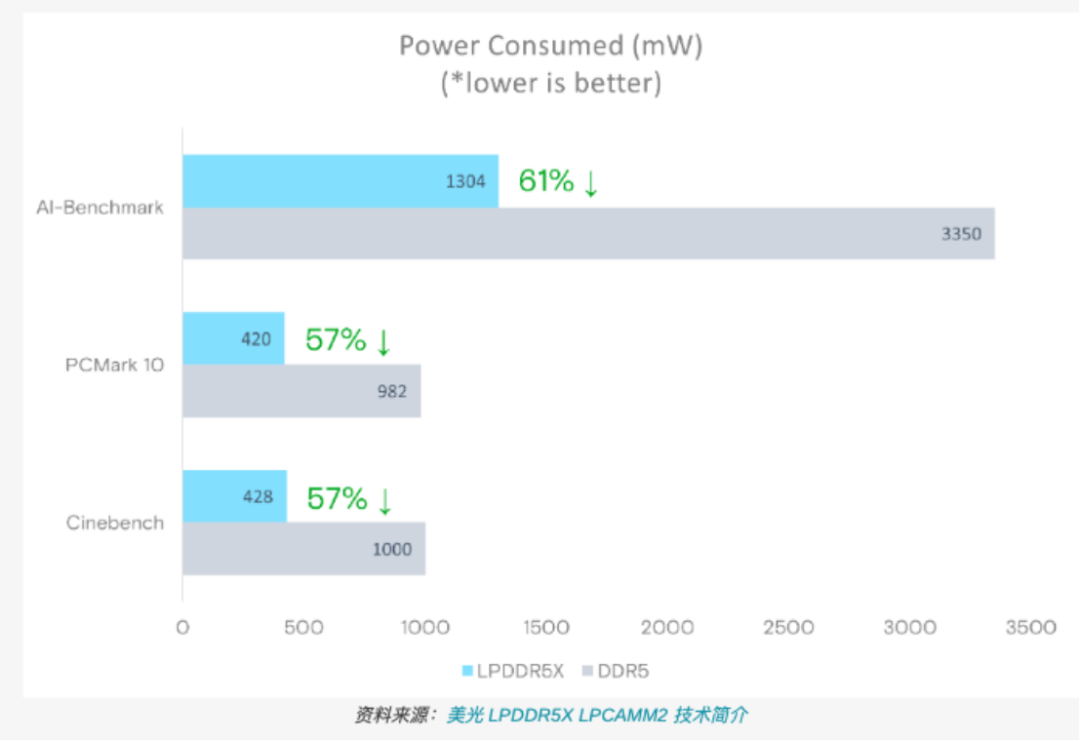Revolutionizing Memory with LPCAMM2
![]() 05/18 2025
05/18 2025
![]() 580
580

Mounted on a compact circuit board near the CPU of a laptop, LPDDR chips are held in place with screws. LPCAMM2 (Low-Power Compression Attached Memory Module 2) combines the efficiency and speed of LPDDR with a sleek, upgradable design. It features a clever interface that brings everything closer to the CPU, making it seemingly capable of doing it all. Additionally, LPCAMM2 boasts dual-channel performance, allowing a single module to handle the workload of two traditional SO-DIMM memory sticks, while occupying less space and offering superior heat dissipation.
Finally, the masses have embraced modular, high-performance, and energy-efficient laptop memory.
Does LPCAMM2 possess no weaknesses? Will it revolutionize the entire industry?
As a vital component of a computer, memory is responsible for temporary data storage and processing, directly impacting the computer's operating speed and multitasking capabilities. According to a JEDEC report, laptop DRAM power consumption accounted for 15%-20% in 2023.
Data Storage and Retrieval: Memory temporarily stores running programs and data. Insufficient memory prompts the system to frequently use virtual memory, increasing hard drive read/write operations and slowing down speeds. For instance, running multiple large software applications with inadequate memory can make the system sluggish.
Bandwidth and Frequency: Memory bandwidth and frequency also affect performance. Higher bandwidth and frequency enable faster data transmission, enhancing system response speed.
When memory becomes a bottleneck, system memory usage approaches 100%, causing frequent memory swap operations and affecting overall performance. Additionally, low memory bandwidth and frequency slow down data transmission speeds, further impacting CPU and GPU performance.
Compared to traditional latch-type SODIMM memory, LPCAMM2 offers significant volume advantages.
First, LPCAMM2's volume is significantly smaller. It still requires only a single module to achieve a full 128-bit width layout, but its module size has been reduced from approximately equal to the area of two SODIMM memory sticks in the previous generation to only about 40% of the size of a single SODIMM. In other words, it's roughly equivalent to the area of two SD memory cards. This makes it possible for not only standard 15- and 16-inch gaming laptops but even 13-inch or smaller tablets or X86 handheld consoles to "fit" this new replaceable memory module.
Second, LPCAMM2 significantly increases the operating frequency of the memory module itself. In the previous CAMM era, its main frequency could only reach 4800MT/s or even lower (especially for ultra-high-capacity models). However, the smaller module size seems to have brought significant electrical performance improvements to LPCAMM2 (shorter wiring), allowing it to simultaneously achieve a single capacity of 96GB and an ultra-high operating frequency of 7500MT/s. This far exceeds the 5600MT/s SODIMM memory used in some current "gaming laptops" and even matches the bandwidth levels of thin-and-light laptops that employ ultra-short memory wiring.
Lenovo's UltraBook provides a good example. Lenovo's ThinkPad X1 Carbon, a benchmark for business ultra-thin laptops, faces critical challenges in the thermal design of its DDR5 SODIMM (Small Outline Dual In-line Memory Module).
Thermal Challenges of DDR5 SODIMM:
1. Increased Power Consumption and Heat Generation: Compared to DDR4, DDR5 memory has a lower operating voltage (1.1V) but a significantly higher frequency (starting at 4800MHz), resulting in increased power consumption per unit area. Under high loads (such as AI computing, video rendering), DDR5 SODIMM temperatures may exceed 80°C, affecting stability.
2. Space Limitations in Ultra-thin Laptops: Ultra-thin laptops (like the X1 Carbon) have compact internal spaces with memory modules closely attached to the motherboard, limiting heat dissipation space. Traditional cooling solutions (such as heat sinks, heat pipes) are difficult to apply directly.
3. Balancing Performance and Heat Dissipation: Adopting aggressive cooling designs (such as direct fan cooling) may increase noise and thickness, violating the original design intent of ultra-thin laptops. Inadequate heat dissipation may lead to frequency reduction, affecting multitasking performance.
Competitors like the Dell XPS 13 also face DDR5 heat dissipation issues, with some vendors choosing LPDDR5 (soldered memory) to reduce power consumption but sacrificing upgradability. LPDDR5X memory technology is gradually becoming the mainstream choice for ultra-thin laptops. However, traditional LPDDR5X memory employs a BGA packaging method directly soldered onto the motherboard, which, while saving space, brings issues such as difficult maintenance and limited upgrades. In response to this industry pain point, innovative packaging technology based on SK Hynix's 16Gb die emerged, achieving a detachable design for the first time while maintaining the high-performance and low-power advantages of LPDDR5X, bringing a revolutionary breakthrough to ultra-thin laptop memory solutions.
The core of this innovative technology lies in the redesign of traditional LPDDR5X packaging processes. By optimizing PCB traces and contact layouts, the originally soldered memory dies are transformed into pluggable SODIMM-like modules without significantly increasing thickness. This design cleverly balances space occupancy and maintainability, enabling ultra-thin laptops to enjoy the freedom of memory upgrades. Test data shows that modules using this technology maintain the same performance as soldered LPDDR5X while reducing repair and replacement costs by more than 50%, which is significant for business users who prioritize long-term usage value.
From an industry perspective, this technological breakthrough provides PC manufacturers with more flexible product strategy options. Traditional soldered memory solutions force manufacturers to determine memory capacity during production, while the detachable design allows for an on-demand upgrade business model. More importantly, this solution employs a standardized interface design compatible with existing SODIMM slot architectures, significantly reducing supply chain management difficulty. As SK Hynix and other vendors continue to optimize the yield rate of 16Gb dies, this innovative packaging is expected to become the new standard for ultra-thin laptop memory, finding the optimal balance between performance, cost, and maintainability.
Samsung
In the second half of 2023, Samsung, a major Korean memory manufacturer, announced the launch of LPCAMM memory featuring LPDDR design. Samsung stated that LPCAMM is the industry's first low-power compression attached memory module, and LPCAMM samples with a current transfer rate of 7.5Gbps have passed system verification on Intel platforms. Compared to SO-DIMM, LPCAMM offers a 50% performance improvement, a 70% reduction in energy consumption, and a 60% reduction in motherboard space occupancy. It can be used in next-generation desktops and laptops and may expand to data centers in the future.
Samsung pointed out that for a long time, many desktops and laptops have used LPDDR memory or DDR-based SO-DIMM. While LPDDR has a compact structure, being packaged onto the motherboard makes repairs or upgrades difficult. On the other hand, while the SO-DIMM design is easy to replace, it has limitations in terms of performance and size. Therefore, the new generation of LPCAMM overcomes the shortcomings of both, meeting the requirements for higher efficiency and compactness while also being a detachable module, enhancing the flexibility of PC manufacturers.
Samsung emphasized that LPCAMM's power-saving features may become attractive for server applications in the future. Because theoretically, it can reduce total cost of ownership (TCO) and has enormous potential in future data center and server solutions.
In this regard, Yongcheol Bae, Executive Vice President of Samsung's Memory Product Planning Group, stated that as the demand for innovative memory solutions with high performance, low power consumption, and manufacturing flexibility continues to grow, LPCAMM is expected to see widespread adoption.
Micron
In the first half of 2024, Micron announced that its Crucial brand, which focuses on consumer storage products, is launching LPCAMM2 memory. As a revolutionary laptop memory design, it is equipped with LPDDR5X dies, enhancing mobile device performance for professionals and content creators. Recently, Lenovo launched the new ThinkPad P1 Gen 7 mobile workstation, which has adopted Micron's new product, making it an ideal high-performance memory solution for AI PCs and handling complex workloads.
Crucial's LPCAMM2 memory operates at 1.05V with a data transfer rate of 7500 MT/s, 1.3 times that of ordinary DDR5 SO-DIMM. Compared to DDR5 SO-DIMM, LPCAMM2 reduces operating power consumption by 58%, standby power consumption by 80%, and saves 64% of space. Although LPDDR5X has higher latency than DDR5, it can be offset by its higher data transfer rate. Compared to soldered LPDDR5X memory subsystems, this modular design does not increase the latency of LPDDR5X memory.

Currently, Micron and Samsung are the only two manufacturers producing LPCAMM2 memory modules. Without more vendors joining, the popularity of LPCAMM2 memory modules still faces certain challenges.
In 2024, the first batch of laptops equipped with LPCAMM2 memory – Lenovo's ThinkPad P1 Gen 7 – came with up to 64GB of new memory, but such products are still rare. It is now possible to purchase individual LPCAMM2 memory modules for future compatible laptops, but as expected, they are not cheap.
Crucial's 32GB LPCAMM2 LPDDR5X-7500 memory module is priced at $174.99 (now available), and the 64GB memory module is priced at $329.99 (shipping within two weeks). In comparison, the company's 32GB DDR5-5600 SODIMM memory module is priced at $108.99.
The premium price is justified. The new memory offers significantly higher speeds than LPDDR5 and is available in a 64GB capacity version. Additionally, it is a new product on the market, and staying at the forefront comes at a cost. Furthermore, the current limited number of laptops supporting new memory and decreased demand usually lead to price increases.
In practical applications, LPCAMM2 memory also performs exceptionally well. For example, on the MacBook Air M2, a 16GB memory configuration easily handles daily video editing, remote work, and photo editing tasks. When using Final Cut Pro for video editing, 4K video playback and processing are very smooth, with almost no lag. During remote work, using GlobalProtect and Parallels Client software for over 8 hours does not cause significant heating issues.
Moreover, when playing 4K movies, hand temperature only rises slightly, without overheating. The only temperature peak occurs when using Bilibili, but it is still within an acceptable range. This performance is very satisfactory, especially under long-term high-load operations, where the computer still maintains smooth operation.





